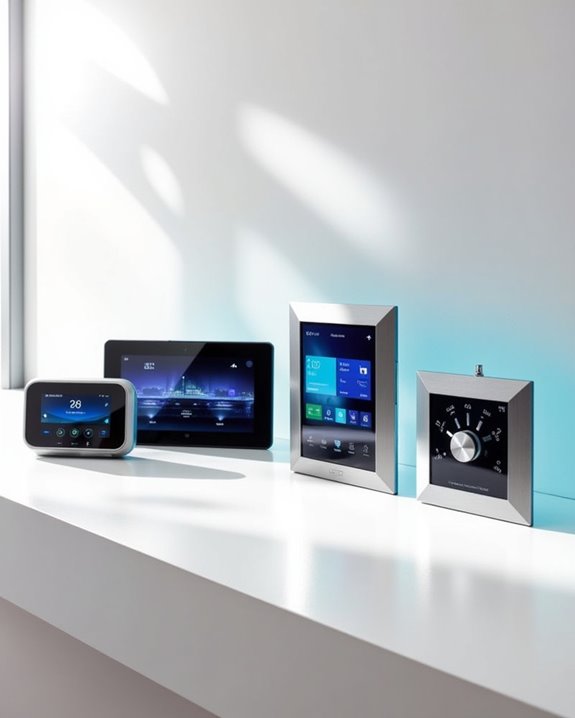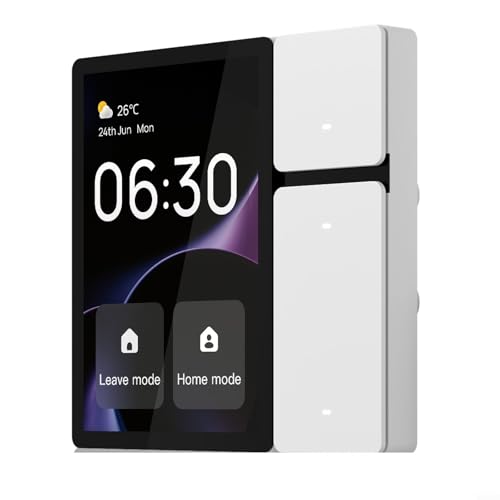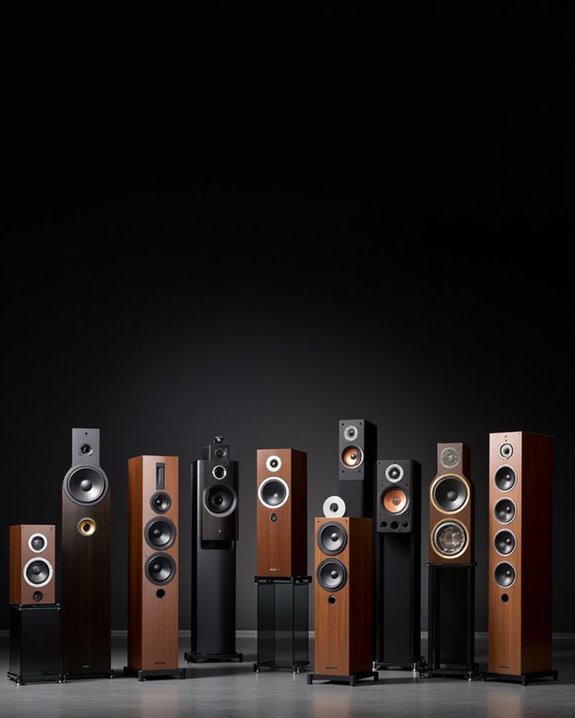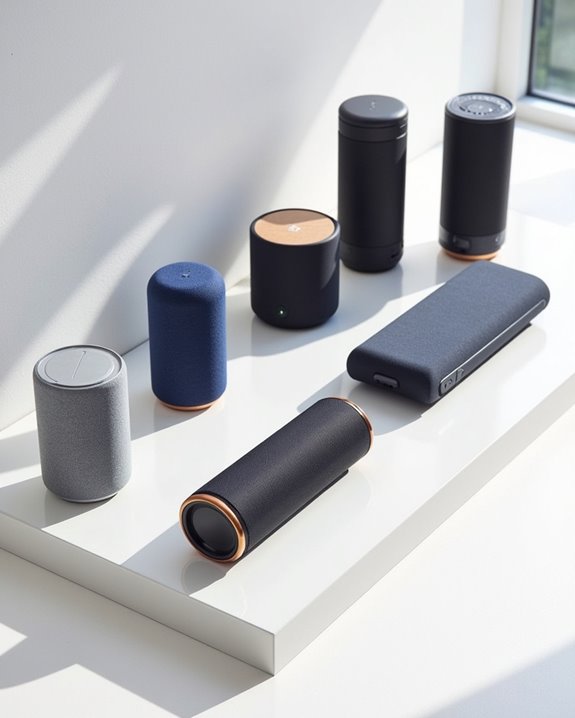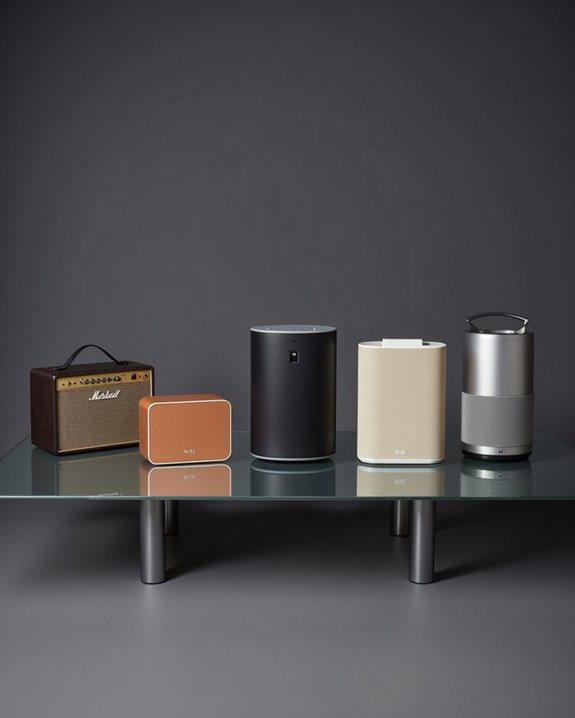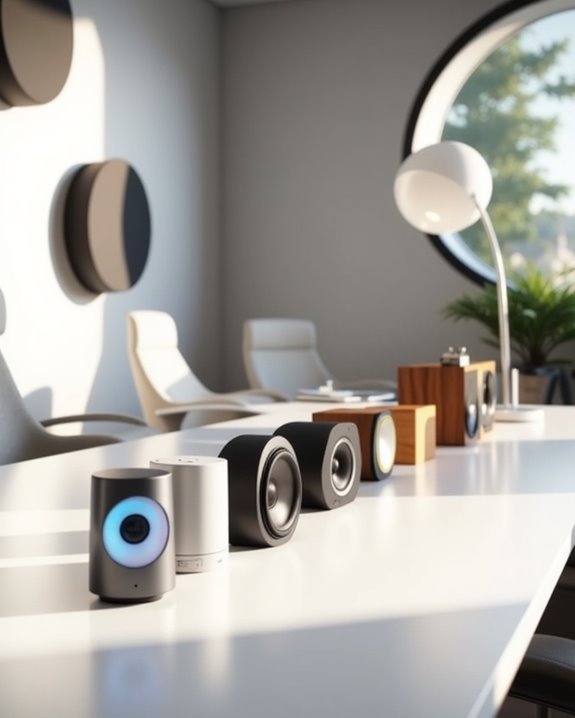Five leading smart home control panels offer thorough device management: The Amazon Echo Hub 8” features WiFi, Bluetooth, Zigbee, Matter, and Thread protocols with a 1280×800 touchscreen; SONOFF NSPanel Pro includes an integrated Zigbee gateway; the Smart Home Touch Panel controls 110+ device categories; the Echo Hub Bundle manages cameras and thermostats; and the Smart Home 10″ Touch Panel runs Android 11 with POE support. Understanding each panel’s unique capabilities will help determine the best fit for your setup.
Key Takeaways
- Amazon Echo Hub leads with its 8-inch display and extensive compatibility with 140,000+ devices through WiFi, Bluetooth, Zigbee, Matter, and Thread protocols.
- SONOFF NSPanel Pro offers a compact 4.7-inch display with integrated Zigbee gateway and supports up to 4 camera feeds.
- Smart Home 10″ Touch Panel provides the largest screen size with Android 11, quad-core processor, and versatile mounting options.
- All-New Echo Hub Bundle enables comprehensive security control with Ring integration and customizable dashboard for camera feeds.
- Smart Home Touch Control Panel features GFF capacitive touch technology and supports over 110 device categories with IR capabilities.
Amazon Echo Hub 8″ Smart Home Control Panel with Alexa
- Echo Hub — An easy-to-use Alexa-enabled control panel for your smart home devices—just ask Alexa or tap the display to control lights, smart plugs, camera feeds, and...
- Streamline your smart home — Customize the controls and widgets, displayed on your dashboard to quickly adjust devices, view cameras, start routines, and more.
- Works with thousands of Alexa compatible devices — Compatible with thousands of connected locks, thermostats, speakers, and more. WiFi, Bluetooth, Zigbee, Matter,...
The Amazon Echo Hub 8″ Smart Home Control Panel stands out as an ideal choice for smart home enthusiasts who need centralized control over multiple connected devices. Its 8-inch touchscreen display offers 1280 x 800 resolution, while supporting WiFi, Bluetooth, Zigbee, Matter, and Thread protocols for broad compatibility.
You’ll find extensive control over lights, locks, cameras, and thermostats through the panel’s intuitive interface. The device’s MediaTek MT8169 A processor handles basic functions well, though you may notice some lag during media streaming. At 7.9 x 5.4 x 0.6 inches, it’s wall-mountable with included hardware, and you can power it via USB-C or PoE adapter. Privacy features include a mic-off button and voice recording controls.
Best For: Smart home enthusiasts looking for a centralized wall-mounted control panel to manage multiple connected devices and routines through a touchscreen interface.
Pros:
- Extensive device compatibility with support for multiple protocols (WiFi, Bluetooth, Zigbee, Matter, Thread)
- Comprehensive smart home control features including security, lighting, and HVAC management
- Easy wall-mounting installation with included hardware and flexible power options (USB-C or PoE)
Cons:
- Noticeable lag when streaming media or music content
- Interface can be slow and Thread connectivity shows stability issues
- Not optimized for video playback or entertainment purposes
SONOFF NSPanel Pro 120 Smart Home Control Panel
- 【All in One Control Panel With】 Enjoy a larger view with the 4.7-inch display that Control your home with just a tap—whether it’s monitoring energy use, viewing...
- 【Home Security】Customize 3 modes by setting different arming devices. When a sensor is triggered, the panel will sound an alarm and send a notification to your phone
- 【Power Consumption】 You can select devices with energy statistics functions to track their daily energy consumption over a week
For smart home enthusiasts seeking complete control, SONOFF’s NSPanel Pro 120 serves as a centralized command hub with its integrated 4.7-inch display and Zigbee gateway capabilities. You’ll manage everything from security modes to energy monitoring, camera feeds, and home automation through one interface.
The panel measures 4.8 x 3 x 1.7 inches and offers customizable security features with three arming modes, instant notifications, and live camera monitoring for up to 4 feeds. While the display’s viewing angles and response time need improvement, you can integrate it with Home Assistant via webpage access. Current limitations include Zigbee component visibility issues and settings reset problems during router-gateway switching.
Best For: Smart home enthusiasts who want a centralized wall-mounted control panel with integrated security, camera monitoring, and energy tracking capabilities in one device.
Pros:
- All-in-one solution with integrated Zigbee gateway and 4.7-inch touchscreen display
- Supports up to 4 camera feeds with live monitoring capabilities
- Customizable security features with three arming modes and instant notifications
Cons:
- Poor screen viewing angles and slow touch response time
- Issues with Zigbee component visibility and connectivity
- Settings reset problems during router-gateway switching experiments
Smart Home Touch Control Panel with Adjustable Indicator
- WIDE RANGE OF APPLICATIONS: This smart home control panel is compatible with a variety of devices, including door locks, sockets, switches, thermostats, speakers, lights,...
- ERGONOMIC KEYBOARD CONFIGURATION: The control panel adopts a unique three-zone two-segment asymmetric key layout to maximize usability, while enhancing the infrared...
- CUTTING-EDGE TOUCH SCREEN FUNCTION: For MOES smart controller adopts advanced GFF capacitive touch technology to achieve precise multi-touch function, which can assure a...
Modern homeowners seeking thorough device management will find exceptional value in this sophisticated touch control panel, which seamlessly integrates with over 110 device categories and 12 infrared-enabled products. The panel’s GFF capacitive touch technology delivers precise multi-touch functionality, ensuring responsive control of your connected devices.
You’ll appreciate the thoughtful three-zone, two-segment asymmetric key layout that enhances ergonomic operation, while the adjustable firefly indicator provides customizable brightness levels for comfortable viewing. The sunken infrared remote control LED maximizes the controllable angle, allowing you to manage your door locks, thermostats, speakers, lights, and security systems with remarkable efficiency. This central hub effectively streamlines your home automation needs through uniform device and scene control.
Best For: Tech-savvy homeowners who want comprehensive control over multiple smart devices through a single, sophisticated interface with customizable display settings.
Pros:
- Extensive device compatibility with over 110 categories and 12 infrared devices makes it a versatile central hub
- Advanced GFF capacitive touch technology ensures precise and responsive multi-touch control
- Adjustable firefly indicator allows for comfortable viewing in various lighting conditions
Cons:
- May require significant initial setup time to configure all compatible devices
- Learning curve might be steep for users less familiar with smart home technology
- Limited to 12 infrared devices, which could be restrictive for homes with many legacy appliances
All-New Echo Hub Bundle | Frame, Metallic
- Bundle Includes: Echo Hub & Made for Amazon Frame | Metallic
- INTRODUCING ECHO HUB — An easy-to-use control panel for your smart home devices—just ask Alexa or tap the display to control lights, smart plugs, camera feeds, and...
- STREAMLINE YOUR SMART HOME — Customize the controls, widgets, and cameras displayed on your dashboard to quickly adjust lights, arm security systems, play music, start...
Smart home enthusiasts seeking centralized control will find the All-New Echo Hub Bundle with Frame Metallic an ideal command center, offering thorough management of over 140,000 compatible devices through a sleek wall-mounted interface. You’ll have complete control over cameras, lights, locks, and thermostats via Alexa voice commands or intuitive touch controls.
The system supports multiple connectivity protocols including WiFi, Bluetooth, Zigbee, Matter, and Thread, ensuring broad compatibility. You can customize your dashboard with widgets, camera feeds, and frequently used controls, while managing security features like Ring systems and compatible locks. Installation options include standard wall mounting with power outlet or power-over-ethernet, though you’ll need to purchase adapters or table-top stands separately.
Best For: Smart home enthusiasts and tech-savvy homeowners who want a centralized, wall-mounted control hub for managing multiple smart devices and security systems through a single interface.
Pros:
- Extensive device compatibility with over 140,000 smart home products and multiple connectivity protocols
- Customizable dashboard with intuitive touch controls and Alexa voice command options
- Comprehensive security features including Ring system integration and camera feed monitoring
Cons:
- Additional purchases required for certain mounting options (power-over-ethernet adapter, table-top stand)
- Professional installation may be needed for clean in-wall cable management
- Wall-mounting requirement may not suit all home layouts or rental properties
Smart Home 10″ Touch Panel POE (Android 11)
- SYSTEM: ANDROID 11
- CPU: RK3566 Quad-core Cortex-A55 1.8GHz
- RAM + ROM: 4G+32G
Homeowners seeking a dedicated control hub will find the Smart Home 10″ Touch Panel POE an capable solution, powered by Android 11 and compatible with popular platforms like Home Assistant and FullyKiosk.
The panel’s RK3566 quad-core processor and 4GB RAM deliver reliable performance, while its flush-mount design fits standard US/EU electrical boxes. You’ll appreciate the versatile connectivity options, including 2.4/5GHz WiFi, Bluetooth, and POE or 12V DC power. The 2MP front camera and 10-inch touch display, though experiencing slight delay, provide adequate functionality for most automation tasks. While the Android 11 OS might be dated, it’s stable enough for common smart home control applications.
Best For: Home automation enthusiasts and DIY smart home owners who need a dedicated wall-mounted control panel with POE capability and compatibility with popular platforms like Home Assistant.
Pros:
- Versatile mounting options compatible with standard US/EU electrical boxes
- Multiple power options including POE and 12V DC
- Comprehensive connectivity with dual-band WiFi, Bluetooth, and Ethernet
Cons:
- Runs on outdated Android 11 operating system
- Touch screen experiences noticeable input delay
- Limited color options (black only) and relatively low camera resolution (2MP)
Factors to Consider When Choosing a Smart Home Control Panel
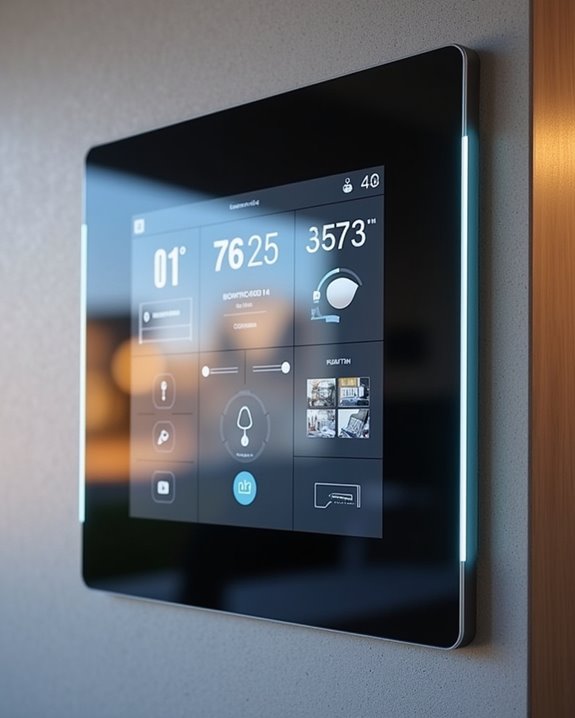
When selecting a smart home control panel, you’ll need to carefully evaluate several critical factors that will determine the system’s effectiveness and usability in your home. Your initial assessment should focus on device compatibility across major protocols like Zigbee, Z-Wave, and Wi-Fi, along with the panel’s installation requirements such as power-over-ethernet (POE) capabilities and mounting specifications. The panel’s display quality (measured in resolution and brightness), interface responsiveness, security protocols (including encryption standards), and connectivity options (Wi-Fi, ethernet, or cellular backup) will greatly impact your daily interaction with the system and its overall reliability.
Device Compatibility Range
The extensive device compatibility range of a control panel serves as an essential factor in creating a truly integrated smart home ecosystem. You’ll find that modern control panels support over 100 device categories, from essential security components like smart locks to comfort features such as thermostats and lighting systems.
When selecting your control panel, you’ll want to verify its wireless protocol support, including WiFi, Bluetooth, Zigbee, Matter, and Thread, ensuring seamless connectivity across your home network. Today’s panels can integrate thousands of individual devices from different manufacturers, while supporting up to 12 IR-controlled appliances for legacy device compatibility. Your control panel should also accommodate energy monitoring tools and security devices, letting you create a complete automation system that meets your specific needs and allows for future expansion.
Installation Requirements
Successful smart home control panel installation starts with a thorough assessment of your home’s infrastructure and technical requirements. You’ll need to verify your power options, whether it’s a standard electrical outlet or PoE capability, to confirm proper functionality at your chosen mounting location.
Check the physical requirements carefully before installation. You’ll want to measure the mounting space, confirm the wall can support the panel’s weight, and confirm you’ve got all necessary mounting hardware. If you’re planning a flush-mount installation, you’ll need to account for in-wall cable routing to maintain a clean appearance. Consider your network connectivity needs, as you’ll require either a strong WiFi signal or direct Ethernet access at the installation point. Don’t forget to verify that the panel’s dimensions will fit your intended space while remaining easily accessible.
Display and Interface Quality
Display quality stands as an essential factor in smart home control panel selection, directly impacting your daily interaction and control experience. You’ll want to focus on screens offering at least 1280 x 800 resolution, which delivers crisp visuals and guarantees you can read multiple controls clearly.
When evaluating display options, you’ll need to evaluate screen sizes between 4 and 10 inches. Larger displays let you view more controls simultaneously, while smaller ones offer better portability. Look for panels featuring capacitive touch technology, as they’ll provide precise multi-touch control and reduce input errors. The panel’s viewing angles and ambient light sensors are essential, automatically adjusting brightness for ideal visibility in different lighting conditions. Pay attention to interface response times, measured in milliseconds, as lower lag times will give you smoother, more responsive control of your smart home devices.
Security and Privacy Features
Since smart home control panels serve as central hubs for your household’s automation, robust security and privacy features must form the foundation of your selection criteria. You’ll want to prioritize systems that offer thorough arming and disarming capabilities through sensor-based triggers, paired with instant notifications to your mobile devices.
Look for control panels featuring physical microphone kill switches, which give you direct control over audio capture prevention. Wake word technology should be standard, ensuring your device only activates when specifically prompted. The ability to access and delete stored voice recordings provides essential data management control. Additionally, verify that the manufacturer guarantees multi-year software security updates to protect against emerging threats. These features work together to create a secure, privacy-focused foundation for your smart home ecosystem.
Power and Connectivity Options
The power and connectivity infrastructure of your smart home control panel plays an essential role in guaranteeing reliable, seamless operation throughout your living space. You’ll find versatile power options, including USB-C delivery specifications supporting 5V/2.4A or 9V/3A, while PoE capabilities can efficiently combine both power and data transmission through a single cable.
For wireless connectivity, look for panels featuring dual-band WiFi 802.11a/b/g/n/ac standards, which deliver robust performance across multiple frequencies. Modern panels should support essential protocols like Bluetooth for device pairing, along with Zigbee and Thread for creating reliable mesh networks. Consider models that incorporate the Matter standard, as it’ll guarantee broader compatibility with various smart home ecosystems. A dedicated Ethernet port provides a dependable wired connection option, particularly useful when consistent, high-speed connectivity is vital.
Frequently Asked Questions
Can Smart Home Control Panels Work During Power Outages?
When darkness falls during a power outage, you’ll find that most smart home control panels won’t function without electricity. However, you can maintain control by installing a battery backup system or uninterruptible power supply (UPS), which provides temporary power to your panel and essential smart devices. Some advanced panels come with built-in backup batteries that’ll keep your system running for 24-48 hours, ensuring you don’t lose access to critical home controls.
How Long Does It Typically Take to Install a Control Panel?
You’ll typically need 2-4 hours for a complete control panel installation, though timing varies based on your system’s complexity. A basic wireless panel takes about 1-2 hours to mount and configure, while hardwired systems require 3-4 hours for electrical work and setup. If you’re replacing an existing panel, you can usually complete the swap in 60-90 minutes. Professional installation is recommended to guarantee proper integration with your home’s systems.
Are Smart Home Control Panels Compatible With Older Home Security Systems?
You’ll find that compatibility with older security systems varies depending on your control panel’s specifications. While many modern panels support integration with legacy systems through Z-Wave or Zigbee protocols, you’ll need to verify specific model compatibility. Some manufacturers offer bridge devices or retrofit modules that can connect older hardwired sensors to new smart panels. If your existing system uses conventional wiring, you might need professional assistance for proper integration.
What Security Measures Protect Control Panels From Hacking Attempts?
You’d think hackers would have better things to do than mess with your thermostat, but here we are. Modern control panels employ multi-layered security protocols, including AES-256 encryption, two-factor authentication, and biometric access controls. Your system’s protected by regular firmware updates, SSL/TLS protocols for data transmission, and secure boot verification. Many panels also feature automatic lockout after failed login attempts, encrypted local networks, and continuous vulnerability scanning to detect potential threats.
Can Multiple Users Have Different Access Levels on the Same Control Panel?
Yes, you’ll find robust user management capabilities in modern smart control panels. You can create multiple user profiles with customized permission levels, allowing you to grant specific access rights for family members, guests, or staff. Primary administrators can set restrictions for secondary users, limiting their ability to adjust certain settings, view sensitive data, or make system-wide changes. Most panels support 8-12 unique user profiles with configurable PIN codes or biometric authentication.

